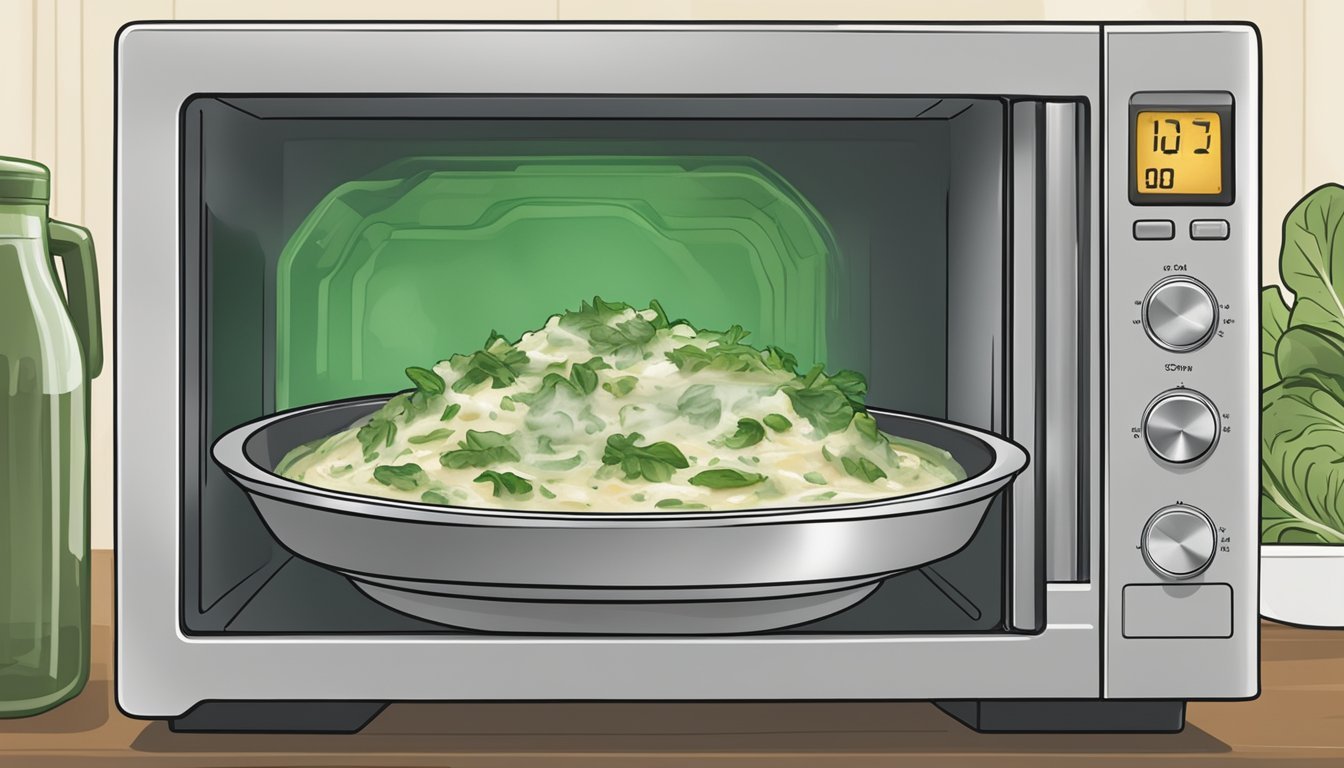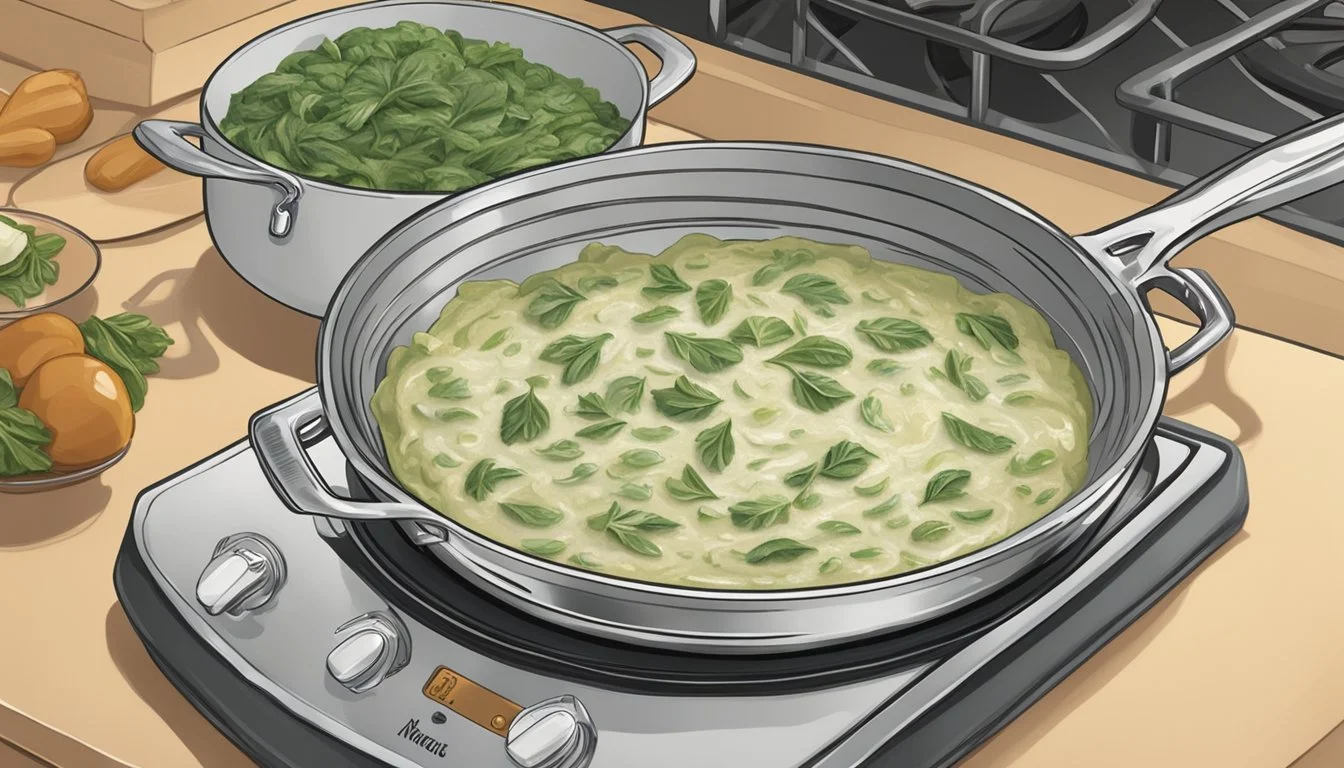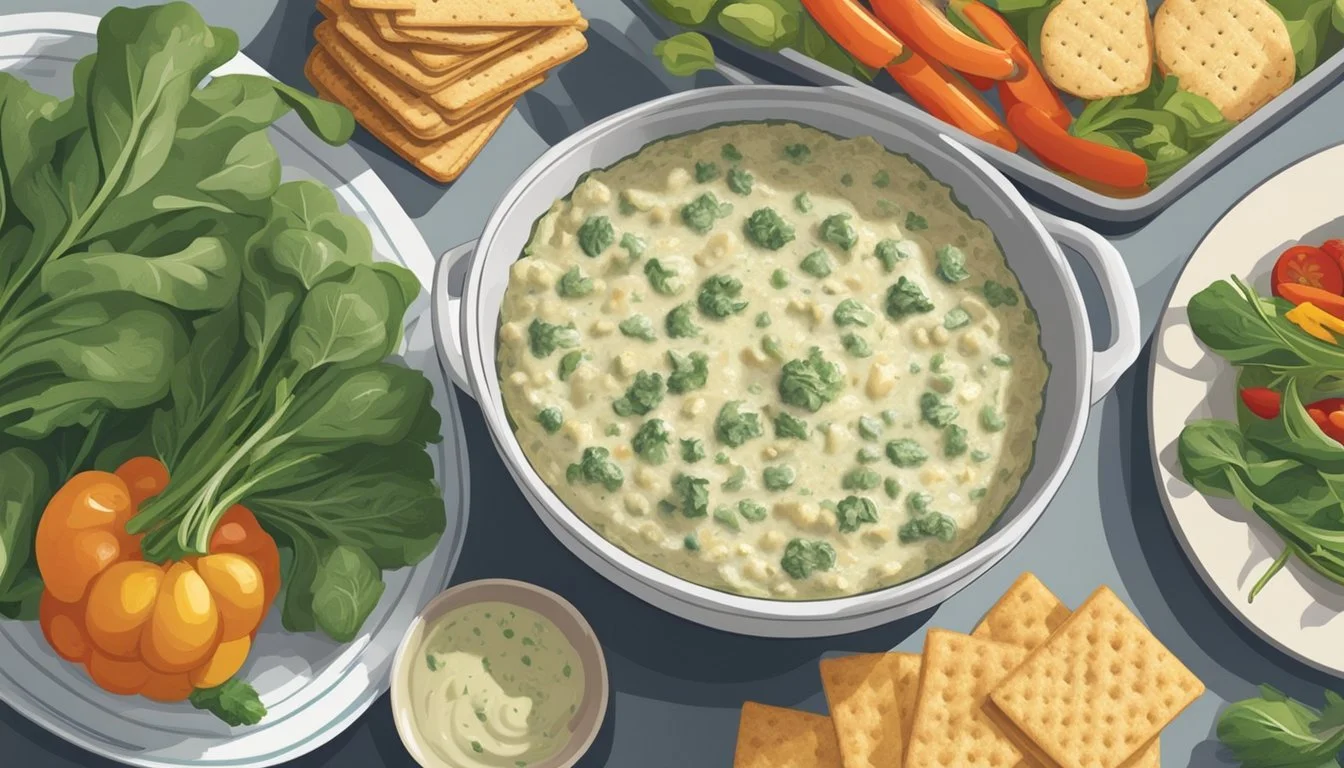Best Way to Reheat Artichoke and Spinach Dip
Maintaining Perfect Creaminess
Artichoke and spinach dip is a beloved appetizer known for its creamy texture and savory flavor. Over time, the dip can lose its initial warmth and creamy consistency, leaving one with the less-than-ideal task of reheating without compromising its taste and texture. The key to successfully reheating spinach and artichoke dip lies in applying gentle heat and preserving moisture to maintain its creaminess.
When reheating, ovens and air fryers can be utilized to bring the dip back to a bubbly and appetizing state. The oven is particularly effective as it heats the dip evenly and gently. Preheating the oven to a moderate temperature of approximately 350°F and using an oven-safe dish covered with aluminum foil can prevent the dip from drying out. The aluminum foil acts as a barrier, ensuring that while the interior warms up, the top doesn't brown excessively.
For those seeking a quicker method, air fryers offer an expedient alternative. A session of about 5 minutes at a higher heat setting around 400°F can suffice to warm through the dip while giving the surface a desirable crispiness. Whatever method chosen, it's crucial to avoid overheating, which can lead to separation of the ingredients and a resulting loss in the rich, creamy texture that defines a good spinach and artichoke dip.
Understanding the Components of Spinach Artichoke Dip
To ensure optimal reheating of spinach artichoke dip, it is critical to understand its primary ingredients and how their unique properties are affected by heat, which in turn impacts flavor and texture.
Primary Ingredients and Their Roles
The creamy texture and rich flavors of spinach artichoke dip come from its primary components which typically include cream cheese, sour cream, or mayonnaise, as the base that gives the dip its creamy consistency. Artichokes and spinach provide the dip's characteristic heartiness and are supplemented by cheese, such as Parmesan or mozzarella, which imparts a gooey texture and a savory taste. Often, garlic, onions, and a blend of herbs and spices are added to enhance the depth of flavor.
Cream Cheese: Adds creaminess and rich taste.
Spinach: Provides an earthy flavor and a nutritional boost.
Artichokes: Offer a subtle, slightly tangy flavor and meaty texture.
Cheese: Melts into the dip, contributing to the indulgent texture.
Aromatics and Seasonings: Garlic, onions, and spices like salt and pepper intensify the delicious flavors.
Impact of Reheating on Flavor and Texture
Reheating can significantly alter the taste and consistency of a spinach artichoke dip if not done properly. High temperatures can cause the dairy components, particularly cream cheese, to separate, leading to an oily, less appetizing dip rather than the wanted creamy texture. The vegetables, primarily artichokes and spinach, are also susceptible to overcooking, which can result in a mushy or dry outcome, diminishing the pleasurable mouthfeel and diluting the vibrant, delicious flavors. Efficient reheating should preserve the dip's harmonious balance of creamy and hearty elements.
Preparation for Reheating
To preserve the creaminess and flavor of leftover spinach artichoke dip, one must carefully select the reheating method and meticulously prepare the dish and appliances before warming it up.
Choosing the Right Reheating Method
Reheating spinach artichoke dip successfully relies on the method used. The oven or toaster oven is recommended for a uniformly heated and appetizing result. Those seeking a more rapid method can turn to the microwave, while the stove can be utilized to reheat and stir the dip continuously, aiding in retaining its creamy texture. The choice of appliance will influence the overall quality of the reheated leftovers and the final serving suggestions.
Oven/Toaster Oven: Best for even reheating and a delightful crispy top layer.
Microwave: Quick and convenient, more suitable for smaller portions.
Stove: Enables stirring, which helps maintain creaminess, but requires constant attention.
Pre-Reheating Steps and Temperature Setting
Before reheating, preparing the equipment and the dip itself is crucial for preserving its quality. Always preheat the oven or toaster oven to a temperature between 350°F (175°C) and 375°F. For those opting to use a microwave, ensure that the microwave-safe bowl is ready, and for stovetop reheating, prepare a skillet with a lid.
Oven/Toaster Oven:
Preheat to 350°F – 375°F.
Place the dip in an oven-safe dish.
Microwave:
Set aside a microwave-safe bowl.
Adjust power level if needed to avoid overheating.
Stove:
Use a skillet with a lid.
Preparing on low to medium heat is recommended.
Ensure that the dip is transferred to the proper container - an oven-safe dish for oven or toaster oven reheating or a microwave-safe bowl if using the microwave. Covering the dish with foil in the oven can prevent drying out, while stirring occasionally on the stove ensures even heat distribution. Each method requires a specific temperature setting; for example, an oven typically requires a preheat to 350°F (175°C), while microwave reheating might not necessitate a temperature setting but might require a lower power setting or shorter heating intervals with stirring in between.
Oven Reheating for Optimal Results
For those seeking to enjoy leftover spinach artichoke dip with the creaminess and flavor of its initial serving, oven reheating is a standout method. This process not only ensures an even distribution of heat but also provides an opportunity to revitalize the dip's appealing crispy top.
Techniques for Even Heating
Reheating in the oven should begin with preheating to 350°F (175°C). It is essential to place the spinach artichoke dip in an oven-safe dish to withstand the heat. To prevent the top from becoming overly browned and to encourage even heating, one should cover the dip with aluminum foil. This also helps to trap moisture, ensuring that the flavor and creamy texture are retained in the reheated dish. The dip should be baked for approximately 20-25 minutes. One can verify that it's warmed appropriately when it's observed to be bubbly around the edges.
Achieving a Crispy and Golden Top
Upon ensuring that the dip is heated through, the next step is to create the desired crispy top. A sprinkle of breadcrumbs or extra Parmesan cheese atop the spinach artichoke dip before baking can enhance the texture. If opting for breadcrumbs, a light coating of cooking spray can help them adhere and become golden-brown. During the final few minutes of reheating, remove the foil cover to allow the topping to reach a desirable level of crispiness. Watch closely to achieve a golden brown without overcooking. The combination of mozzarella and Parmesan cheese resurfaces the rich flavor and stretchy texture associated with a freshly made dip.
Microwave Reheating for Quickness
When one seeks to quickly reheat spinach artichoke dip while maintaining its creaminess, they find the microwave method to be highly effective. It is imperative to manage moisture levels and adjust the microwave settings appropriately for the best results.
Preventing Moisture Loss
To prevent the dip from drying out, one should place the spinach artichoke dip in a microwave-safe bowl. Adding a small amount of water to the bowl can significantly aid in retaining moisture throughout the reheating process. One may then cover the bowl with plastic wrap; however, it is crucial to leave a small vent to allow steam to escape, creating a gentle steaming effect within the bowl. This assists in keeping the dip creamy.
Steps to retain moisture:
Place the dip in a microwave-safe bowl
Add a light drizzle of water
Cover with plastic wrap, leaving a vent for steam
Adjusting Microwave Settings
Reheating the dip at the correct power level is fundamental to avoid overheating. One should select medium power on the microwave to ensure even reheating. The power level should be set to reheat the dip gradually; typically, a sequence of brief heating intervals, checking regularly between intervals, ensures that the dip reaches the desired temperature without compromising its texture.
Tips for proper reheating:
Use medium power setting on the microwave
Reheat in short intervals, such as 20-30 seconds
Stir the dip between intervals to distribute heat evenly
By following these simple steps with a focus on maintaining moisture and judiciously using the microwave's settings, one ensures that their spinach artichoke dip is reheated quickly while still preserving its delectable creaminess.
Stovetop Reheating for Control
When reheating spinach artichoke dip on the stove, one has precise control over the temperature, which is critical to prevent the dip from separating and losing its creamy texture. This method allows for slow, gentle warming, which ensures that the flavor and texture are maintained.
Using a Double Boiler Technique
A double boiler involves one pot nested inside another, with the bottom pot holding water that is brought to a simmer. One can place their spinach artichoke dip in the top pot, ensuring it does not come into direct contact with the intense heat of the stove. This indirect heat prevents the dip from becoming too hot too quickly. Here's how to effectively use this technique:
Fill the bottom pot with 1-2 inches of water and bring to a gentle simmer on the stove.
Place the dip in a heatproof bowl, and set it over the simmering water, ensuring the bottom doesn't touch the water.
Stir occasionally to ensure even heating.
Maintaining a Creamy Consistency
The key to a creamy consistency when reheating is to heat slowly and to stir frequently. Here's what one should keep in mind:
Heat: One must keep the heat low to medium-low; too much heat can cause the cheese and dairy to separate.
Stirring: Regular stirring distributes the heat evenly and integrates the fats and liquids.
Add-ins: If the dip thickens too much, one can add a small amount of milk or heavy cream to bring back the creamy texture.
Butter: A touch of butter can be introduced for additional richness.
Additional Reheating Tips
When it comes to reheating artichoke and spinach dip, maintaining the dip's creamy texture and rich flavors is paramount. These additional reheating tips will help ensure the dip retains its quality, whether it's been refrigerated or frozen.
Thawing and Preparing Frozen Dip
To ensure even reheating and preserve the flavors, thaw frozen dip in the refrigerator for several hours or overnight. Prior to reheating, one should permit the dip to reach room temperature, which can minimize the risk of an unevenly warmed dish. Leftover dip stored in an airtight container retains quality better and is easier to heat without drying out.
Garnishing and Enhancing Taste
After reheating, consider enhancing the dip with a drizzle of olive oil for moisture and a sprinkle of fresh herbs for vibrant flavor. Garnishing with parmesan cheese can add a savory touch and create a deliciously golden top when broiled for a moment. Incorporating freshly chopped veggies can add crunch, and a dash of protein like shredded chicken can further enrich the dish without adding excessive calories.
Serving and Pairing Suggestions
When it comes to serving artichoke and spinach dip, not only is the flavor important, but so is the selection of accompaniments that complement its creamy texture and rich taste. The right pairing elevates the dip from a simple appetizer to a memorable gastronomic experience.
Suitable Accompaniments for the Dip
The richness of an artichoke and spinach dip, often laden with mayo and sour cream, matches well with a variety of dippers that provide a satisfying crunch and contrast. The following options are recommended:
Bread: Slices of a crusty baguette or pieces of toasted crusty bread offer a chewy texture that pairs exceptionally well.
Tortilla Chips: Their sturdy structure and salty flavor make them an ideal vehicle for the creamy dip.
Crackers: Opt for plain or lightly seasoned varieties to avoid overpowering the dip's flavor.
Vegetables: Fresh vegetables such as carrot sticks or cucumber rounds can offer a refreshing and healthier alternative.
Recommendations for Complete Meals
Including artichoke and spinach dip as part of a larger meal requires selecting dishes that balance out its richness. Here are some suggestions:
Protein: Grilled chicken or fish can provide a lean balance to the creamy decadence of the dip.
Salads: A light, citrusy salad can cleanse the palate between bites of the flavorful appetizer.
Wine: For an adult gathering, consider pairing the dip with a crisp white wine, which can complement the creaminess of the dip without overwhelming it.
Nutritional Considerations
When reheating spinach and artichoke dip, it's essential to pay attention to its nutritional profile. This section analyzes the caloric and fat content, and explores healthier ingredient alternatives to help maintain the dip's flavor while improving its nutritional value.
Analyzing Caloric and Fat Content
Spinach and artichoke dip is rich in both calories and fats due to its typical ingredients like cheese, mayonnaise, and sour cream. A standard recipe could contain the following:
Cheese: High in calories and fats, contributes to creamy texture.
Mayonnaise: Adds a significant amount of fat and calories.
Sour Cream: High in calories and fat, but essential for the dip's consistency.
The specific amounts of these ingredients can greatly vary, but a general breakdown is as follows:
Ingredient Estimated Calories (per tablespoon) Estimated Fat (g) Cream Cheese 51 5 Mayo 94 10 Sour Cream 23 2.5 Cheese 100 (per ounce) 9
The caloric and fat content can add up quickly, making moderation key when enjoying this dish.
Healthier Ingredient Alternatives
In an effort to reduce the caloric and fat content, one can substitute certain components with healthier options without sacrificing the dip’s delectable creaminess. Such alternatives include:
Low-fat or non-fat sour cream: Retains the tanginess with fewer calories.
Greek yogurt: Can replace mayonnaise to offer protein with fewer calories and fats.
Reduced-fat cream cheese: Decreases caloric intake while maintaining a creamy texture.
Skim milk or almond milk: These can be used instead of heavy cream to cut back on fat.
By incorporating these substitutes, one can make a lighter version of the classic spinach and artichoke dip while preserving its rich flavor and creaminess.










